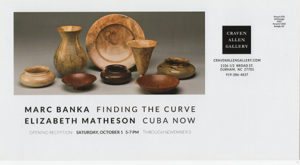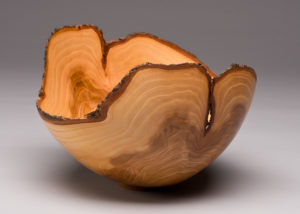CUBA NOW: PHOTOGRAPHS BY ELIZABETH MATHESON and FINDING THE CURVE: WOODTURNING BY MARC BANKA
TWO GREAT SHOWS OPEN AT CRAVEN ALLEN OCTOBER 1
Durham — Two exhibitions, CUBA NOW: PHOTOGRAPHS BY ELIZABETH MATHESON, and FINDING THE CURVE: WOODTURNING BY MARC BANKA, open at Craven Allen Gallery on Saturday, October 1, with a reception with the artists from 5 to 7. The shows continue through November 5.
Elizabeth Matheson, recipient of the North Carolina Award for Excellence in the Arts–the state’s highest civilian honor–returns to Craven Allen Gallery with enigmatic new photographs of Cuba–a country she finds “ . . . deeply and soulfully beautiful, filled with both melancholy and irrepressible delight.” The exhibition is a featured event of the Click! Triangle Photography Festival.
Marc Banka has been working more than a year to present the beautiful collection of handcrafted woodturned pieces in Finding The Curve. “The art comes when the natural beauty of the wood is honored by a shape of equal beauty,” says Banka. “Bowl turning is very physical, and yet I approach it intuitively. With the bowl on the lathe, I often find that touch is more sensitive than what I can see. I am always seeking the beauty of line – the graceful curve – as I uncover the vessel deep inside the tree.” Banka lives in Durham.
Craven Allen Gallery is located at 1106 ½ Broad Street in Durham. Gallery hours are from 10 a.m. to 6 p.m. Monday through Friday, and 10 a.m. to 4 p.m. on Saturday. For more information, please call the gallery at 286-4837 or visit www.CravenAllenGallery.c


ELIZABETH MATHESON
STATEMENT
The claustrophobic and rather sinister atmosphere which unsettled me on my first visit to Cuba two years ago seemed mitigated by outward and visible signs of change–new restaurants, businesses, hotels and, for the first time, Wi-Fi hotspots on the streets of Havana. This show does not reflect any of this! Rather they are photographs of the place which so totally seduced me two years ago: Cuba, deeply and soulfully beautiful, filled with both melancholy and irrepressible delight.
ABOUT ELIZABETH MATHESON
A native of Hillsborough, North Carolina, Elizabeth Matheson earned her BA from Sweet Briar College and later studied at the Penland School of Crafts with John Menapace. One-person exhibitions of her work include Hollins University, the Virginia Polytechnic Institute, the North Carolina Museum of Art, Duke University, Western Carolina University, the National Humanities Center, and the Gregg Museum at North Carolina State University. Her work is in the collections of Duke University, the Ackland Museum, the North Carolina Museum of Art, among many others. Among her publications are To See, poems by Michael McFee, North Carolina Wesleyan Press, 1991; Blithe Air: Photographs of England, Wales, and Ireland, Jargon Society, 1995; and Shell Castle, Portrait of a North Carolina House, Safe Harbor Books, 2008. In 2004, Elizabeth Matheson was awarded the North Carolina Award for Excellence in the Arts, the state`s highest civilian honor.
MARC BANKA
STATEMENT
I approach bowl turning somewhat as a sculptor contemplating a block of marble. A bowl can begin with a log that I pick up on the road side, chain saw off a piece, and mount it on the lathe. As I carefully press the bowl gauge into the wood, ribbons of wood flow off, and I quickly find myself covered in wet wood. As the wood is shaved away, I start to see the figure of the wood and the beginnings of a graceful curve. I am looking for the curve that will turn this into a beautiful vessel – whether it be for daily use or simply to be enjoyed as a work of art.
I especially love working with burl, wood that is highly figured, and wood that has some evidence of decay, or worm tracks, like ambrosia maple. I’m fascinated by the beauty that can be created by worms and the staining they leave behind. Some of my bowls have holes that are actually worm tracks. I see this not as a flaw, but as the signature of the wood, and I do not want to obscure this.
I often turn green wood, that is, wood that has not been seasoned or dried yet. Rarely are my vessels perfectly round, as very little in nature is. I want my bowls to be true to the nature of wood, which moves with the weather. As my bowls release moisture or take it on, they come slightly out of round. I like to let the bowl take its own shape, particularly if I have left the bark on. This gives it a natural edge with a form that is unique to the actual curve of the log. In all cases, I seek a balance between the beauty given by nature and the shapes we find pleasing and useful.
ABOUT MARK BANKA
I started working with wood when I was a teenager. Since that time, I have been a master mechanic, built an award-winning catapult, and worked as a portrait photographer using vintage cameras. Over the past few years, I rediscovered my love of turning wooden bowls. I am largely self-taught, so through my own experience I have come to understand how a lovely shape can be coaxed from a tree. The craft of turning wood has come easily to me, but technical mastery alone doesn’t make art. “The art comes when the natural beauty of the wood is honored by a shape of equal beauty. Bowl turning is very physical, and yet I approach it intuitively. With the bowl on the lathe, I often find that touch is more sensitive than what I can see. I am always seeking the beauty of line – the graceful curve – as I uncover the vessel deep inside the tree. ”
I’m a woodturner based in Durham. I’m a member of the Woodturner’s Guild of North Carolina, and the American Association of Wood Turners.